I wanted my daughter’s 7th birthday party to be memorable for her, her friends, and any parents who wanted to hang around and have a chin-wag. Therefore, I had to find some enjoyable party games for 6 to 8 year-olds. Plus, having some activities planned helped her feel confident that her party would be fun.
After much research, I found/devised/borrowed, and tweaked ten awesome party games for 6 to 8 year-olds from our good friend – the internet. In order to make a great party, you only need two or three fun games. However, when your friends come and ask where you get your ideas from, you can say you have more!
Of course, games can be used on many occasions and don’t always need large groups. Here in Auckland, NZ, we just had another week of lockdown with kids home from school. Adapting some of these games to a family bubble totally saved the day, such as Game#8 and #9.
Children learn so much from playing set games, such as teamwork, strategy, and adaptability. It’s also a great way for them to nurture friendships and develop their social skills.
Below, you’ll find 10 varied and adaptable games. Finally, I’ve tried to be sensitive to the turbulent times, so if you’re lucky enough to be holding a party I’ve included options where physical distancing and less germ trading is possible.
Disclaimer; I’m not a doctor or medical professional. The words in this post are only my thoughts and opinions and if you choose to act on any suggestions those are your own decisions and responsibility.
Related post: How to make parenting more FUN
Games with social-distancing in mind:
Game #1 Balloon stomp
This is one of those excellent games for 6 to 8 year-olds; it gets them full of excitement and teaches kids to bounce back from disappointment when their balloon pops. Also, it works on physical coordination.
You will need:
- String or ribbon
- Bag of balloons
- Balloon pump or a big set of lungs
- Music that you can stop and start
How to play:

- Pump up or blow the balloons up. Even better, get each child to blow up their own balloon and help them tie it off.
- Tie a piece of string onto the balloon and the other end onto each child’s ankle. Make it at least 60cm long. Longer if you’re concerned about physical distancing. (note; it might be a good idea to loosely tie the string or ribbon around ankles with socks on)
- Play the music in bursts. When the music stops players try to stomp and pop other balloons. You can play this without music, but the music will stretch the game out.
- To make it less competitive and give more chances, you can have an adult set up at a Balloon Refueling Station, where kids with popped balloons can get resupplied with a fresh balloon and rejoin the game.
Game #2 Post-it Paper Share
This game is a great ice-breaker and can bring a group of friends closer together, which is important when choosing games for 6 to 8 year-olds. It develops empathy, listening skills and confidence to share.
You will need:
- A big space for children to sit in a wide circle (so physical distancing can be observed if needed). Ideal to play outside under a shady tree if it’s a nice day.
- A pile of multi-coloured post-it notes with nothing written on them.
How to play:
- Get the children to sit in a big circle
- Tell the players that you’re going to hand around a Post-it pad and tell them they should take as many notes as they think they will need for the game. Give no further instructions and pass the pad around. Start by taking 3 or 4 yourself.
- Once each player has as many sheets as they feel they will need, tell them they will share one thing about themselves for each post-it note they have.
- Tell them you will have random quizzes to win a small prize about what others have shared – this is to make sure they keep listening and not think too much about what they will say.
- Start the “Sharing” yourself as this will set the level of expectation. It could be what you had for breakfast, what your favourite colour is, or go a little deeper and share something that makes you feel happy/sad. Emphasize, the idea is to only share what they feel comfortable sharing with the group.
- If they have a huge chunk of notes, see if you can get them to do it at speed without thinking too much.
Game #3 “What are you doing?” drama game
This game is great for confidence building and for freeing up kids who get tangled up with ideas from overthinking. It develops listening, turn-taking, physical awareness, and brain-body coordination. It’s also a great opportunity that there are no “correct” ideas when it comes to freeing up creativity.
You will need:
- A big space for children to stand in a wide circle (so physical distancing can be observed if needed). Ideal to play outside under a shady tree if it’s a nice day.
- Some flashcards with simple actions written on them as suggestions – You can play this game without any props, but if the children seem shy or need some prompting, you can use the flashcards to get them started.
How to play:
- Players stand in a circle (adequate distance for physical distancing if necessary)
- Ask for a volunteer or start yourself by standing in the middle of the circle and act out or mime a simple action, such as “Combing your hair” or, “Brushing your teeth”.
- Someone on the outside circle calls out “What are you doing?” and the player in the middle has to answer with an action different than what they are doing such as “Riding a horse”. They need to try and keep miming their original action without changing to what they’ve responded with. It’s easier if they answer as quickly as possible (before their controlling brain gets in the way)
- These 2 players swap places with the child who asked “what are you doing?” standing in the middle of the circle.
- The new player in the middle begins to act out what the first player responded with – eg: “Riding a horse”.
- A new person calls our“What are you doing?” and the new player in the middle answers with an action different to what they are doing such as “Playing hopscotch” while continuing to “Ride a horse”.
- Repeat until everyone has had a couple of goes in the middle. If possible let players volunteer when they feel ready, but you may need to encourage quieter / shy players to put themselves forward and more confident children to let others have a go.
- Keep the pace up. This isn’t a thinking game and works best and funny suggestions come up when it’s played fast.
Game #4 Guess my capital
This is a clever and energetic way to learn and reinforce some geographical knowledge with a group.
You will need:
- A big space for children to stand in a wide circle (so physical distancing can be observed if needed). Ideal to play outside under a shady tree if it’s a nice day.
- Flashcards with a country written on it with it’s capital underneath.
How to play:
- Players stand in a circle (adequate distance for physical distancing if necessary)
- Hand each player 2 or 3 flashcards each. Tell the group not to show or look at other people’s cards.
- Ask for a volunteer to stand in the middle with their cards and say the name of their country. They could say “I am Germany, what’s my capital city?”
- Players in the circle call out their guess. Up to you if you want this to be calling out all at once or by selection
- The player in the middle has the answer so when they hear the correct answer they call that player to come into the middle to announce their country.
- Repeat until everyone has had a turn. If they have had all their capitals named they can sit down so other people get a chance.
- If no-one can guess the correct capital of a country, you could ask the group if they know where the country is in the world, or what country it’s next to, or what language they speak there.
Non-competitive games for team building:
Game #5 Ice-breaker “Change seats if you…”
You will need:
- Chairs – one less than the number of people playing.
How to play:
- The aim of the game is to get to know things about each other in an energetic way.
- One person starts in the middle and says “Change seats if you ….” then they make a statement like “…have ever eaten pineapple” or, “…brushed your teeth this morning” or, “…are wearing a green t-shirt”
- Everyone who this applies to stands up and has to find a new seat in the circle. They aren’t allowed to take the seat immediately next to them. The person in the middle also takes a seat. This should leave a new person standing in the middle.
- They repeat the statement “Change seats if you ….” and add a new statement.
- Keep playing until everyone has been in the middle a couple of times. If players are taking to long think of statements, remind them it can be something that most people do, and doesn’t have to be a clever statement.
Game #6 Ice-breaker “Stand in this corner if you love cats”
This isn’t competitive in any way, and there’s no endpoint to this exercise. It’s helpful for getting a group to relax around each other. This is because players can see similarities and feel like they’re together in a gentle way that requires only participation. You can change the groupings gradually to more silly categories, in order to make it more fun.
You will need:
- A large room with clear space for people to spread out in.
- A list of things that people like/dislike or have/have not experienced.
How to play:
- Get players to spread out in the room.
- Point out to the group before they move which corners will be the “like” or “dislike” corner.
- Ask them to move to the side of the room that suits your statements which might be “Stand on this side if you like homework” or “Stand in this corner if you like dogs”.
- You can jump from one statement to the next without needing to reset the group, so people get a good mix and mingle. For example; for the group standing in the cat-loving corner, you can ask those that also love dogs to stand in another clump separate. Some will move, some will stay as ardent cat-lovers.
Game #7 Herding animals
This is a wonderful game to play with a large amount of kids who need to tune into and listen to each other, but who also like to make a lot of noise.
You will need:
- Bits of paper with different animals written on them, such as Sheep, Cow, Cat. Choose animals whose sound is easy and obvious. Choose about 4 different animals, so that you have 3 or 4 of each animal, a herd.
How to play:
- Hand out the bits of paper with different animals written on them. Tell the players to keep these a secret at this point.
- In a large space spread the group out.
- Tell them they make up a mix of several different herds of animals and they need to find their group by going up to each other and making their animal sounds.
- Once they find one animal they stick together to find any missing from their herd. You can see why this is good to play in a large group.
- After they’ve all sorted themselves into their own herds you can conduct an animal choir if you like, by getting them to do their animal call as you point to them.
Game #8 Treasure hunt – follow the clues
This classic game can be fun for parents and children. I really enjoy writing the clues and finding silly places to put them. It’s also excellent for teamwork and exploring space in a new way.
You will need:
- A treasure to hide.
- Several bits of paper to write clues on.
- Tape, string, or blue-tack to attach clues inside or outside.
How to play:
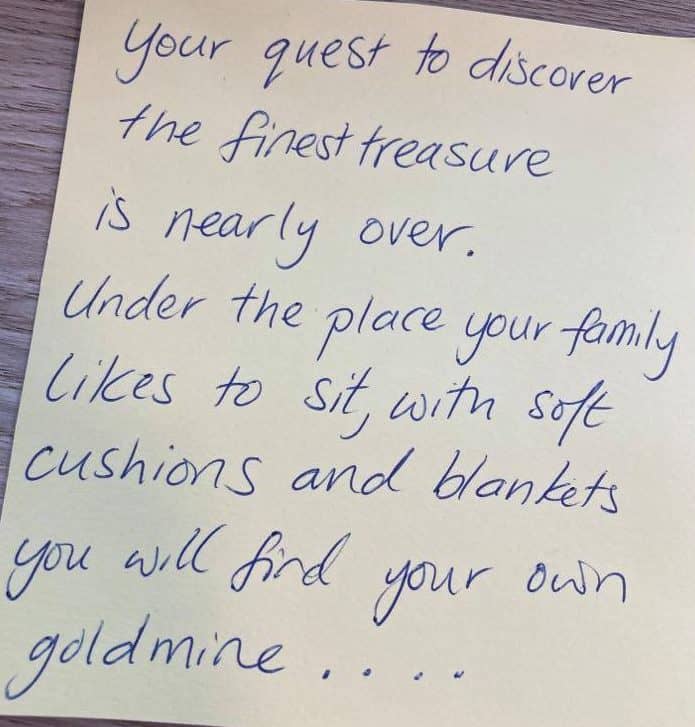
- Setting up the clues first is quickest done backwards: Hide the treasure first and write your last clue which will lead to it. See the picture for an example;
- Or keep the clues simple: You will find the treasure in the branches of your favourite tree to climb.
- Work backwards until you have at least 4 or 5 clues. If you are doing this for a large group of children make enough for two sets of clues, so you can put the kids in teams.
- Secretly place the clues and treasure before gathering the group of children.
- Let them know it’s about working as a team, and that this means sharing who gets to read out the clues and see if you can figure them out together.
Quieter games for indoors or winding-down time:
Game #9 Panda slide – guess the mystery activity
This game can help develop language, conversation and critical thinking, as well as being fun and a bit silly. Plus it doesn’t require running around, so is perfect for calming things down. It can be played with a large group or a small family unit.
You will need:
- A room with a door that can be closed.
How to play:

- Select one player who will be The Detective. Ask them to step out of the room and cover their ears.
- Ask the remaining group to choose an action, such as Swimming, that they have to swap with the phrase Panda Sliding when the detective returns and asks their questions.
- Invite The Detective back into the room to ask the group questions about this mystery activity to see if they can guess. For example:
- “When do you normally do this mystery thing?”
- “I usually go Panda Sliding in the weekend with my grandparents”
- “What does it feel like to go Panda Sliding?”
- “I’m very wet after Panda Sliding”.
- “When do you normally do this mystery thing?”
- Once The Detective has solved the mystery activity, choose a new detective to step out of the room.
- Change the name of the mystery activity so the kids don’t get confused and it keeps the silly factor interesting. Maybe something like Koala Licking, or Tiger tickling.
Game #10 Grow the story – one sentence at a time.
This game puts the emphasis on listening and being adaptable to work as a whole unit, rather than one individual standing out. Also, you can spread the group out if you need to be mindful of physical distancing.
You will need:
- Enough space for your players to sit in a circle.
- A collection of five or six interesting objects from around the house.
How to play:
- Sit the children in a circle and place the objects in the middle, so they can be clearly seen by everyone.
- Players add one sentence at a time to construct a whole story.
- If you have a large group the aim of the game might be to complete a full story by the time you get around the group once. Or for smaller groups, you could go round 2 or 3 times.
- Talk the group through the elements of what makes a good story. For example:
- Characters
- A goal to achieve / or to go on a quest
- A hurdle to overcome / something that makes the goal difficult
- A beginning, middle & end
- Suggest the players use the objects placed in the middle as inspiration for these elements if they feel stuck. For example; one of the objects might be a rolling pin. Someone could say “Once upon a time there was a baker called Sally and she loved to roll pastry in the morning with her gold rolling pin”.
- Once an object has been named by a player, then other players have to incorporate that fact into their story sentence and not use it for one of the other elements. They don’t have to repeat it in their sentence, they just have to remember that this story is about Sally who loves using her rolling pin. This promotes listening and adapting. The players can’t sit there planning their sentence, they have to listen and build on the idea.
- Once the story has found a natural ending ask the group if they want to make another story and reflect on the one they just made –
- What was interesting?
- What might have made it better or more exciting?
- Can the ending be more satisfying?
- Did it have all the elements of a good story?
Why playing games is important for kids
Children are hardwired to play and have fun. And they are hardwired to learn. So games are the natural place for these two features to meet. Within the world of a good game they are the creator and get to be in control.
The joy that’s exchanged between players in the thick of a good game, is the essence of life. And it’s accessible to all of us. We don’t always need fancy gadgets and kit sets to create a basic game. What is important in games for 6 to 8 year-olds is the connection between players and the feeling of collaboration and friendship.
There’s a wealth of research that play and playing games can help develop strategy and critical thinking. Some board games zero in on developing this; games such as Connect Four, Battleship, or chess encourage players to think one or two steps ahead in several different directions. It’s mental gymnastics.
Related post: Benefits of tree climbing
Create your own games and add your own twist
What’s the ingredients of a good game? Sure it’s debatable, but my version of what makes a game interesting has a certain mix of these elements:
- Challenge or conflict, and incorporating smaller challenges within, or leads to the next challenge once one is achieved
- Reward
- Theme & story – narrative can help players remember the rules, and spark their imagination
- Rules and parameters to play within
- Strategy vs chance

When New Zealand went into our initial 7-week lockdown in 2020, the pressure and need for sheer mental survival called for some creativity. Both our girls decided that they wanted to do indoor gymnastics and created interesting obstacle courses with the furniture. This reminded us of the Olympics for some reason. The 2020 Tokyo Olympics that never was.
So we made our own Olympics.
One morning we gathered all the ribbon, tinfoil and gold paint that we could find and fashioned a handful of medals.

Then we set up 4 or 5 nonsensical events throughout the house and garden. One was even in the shed amongst the camping mattresses. That particular one involved “diving for baby mermaid fish” – which of course my husband and I were just no good at.
At the closing of each competing event the winners were announced, they stepped up onto a stool, music played and medals were awarded. Interestingly, the parents didn’t win ANY of the medals.
But we did win that particular day of lockdown.
If you like this post please share, or get in touch and tell me what your thoughts are. I love hearing from my readers.
Lastly, if you want to know more about what I hope you’ll find at Not So Perfect Parenting, read my post on 5 Things I want to help my audience with.
Check out my other posts

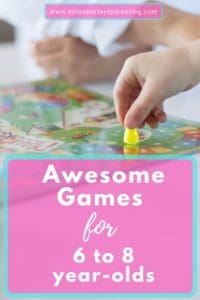
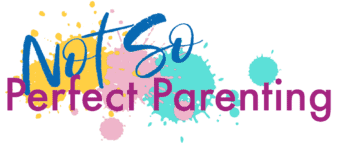
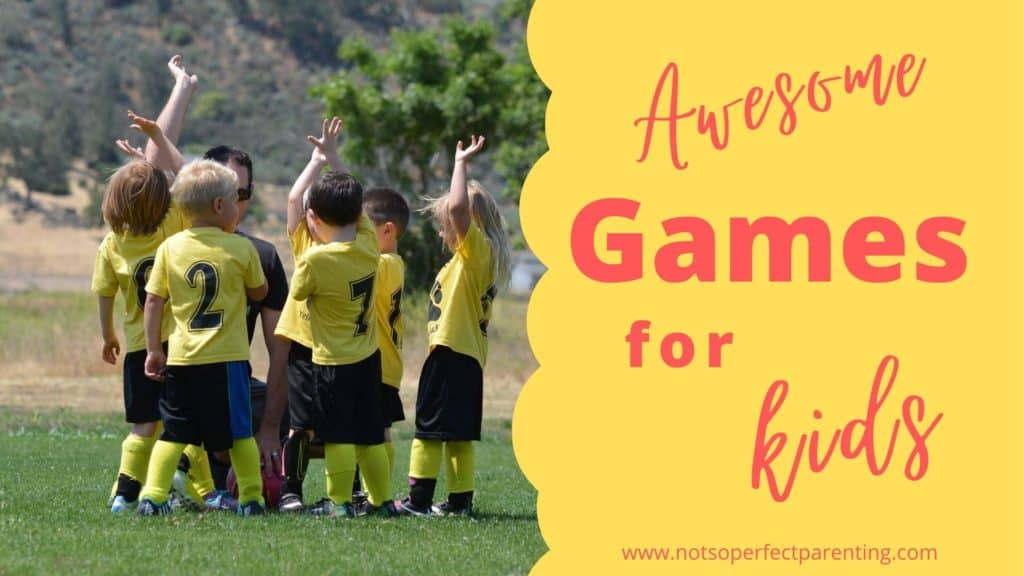

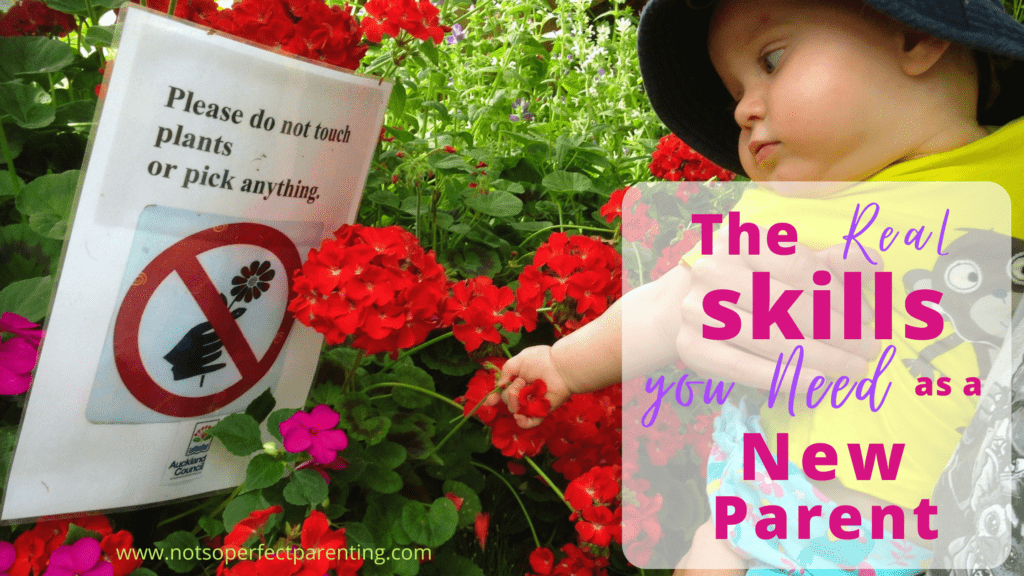
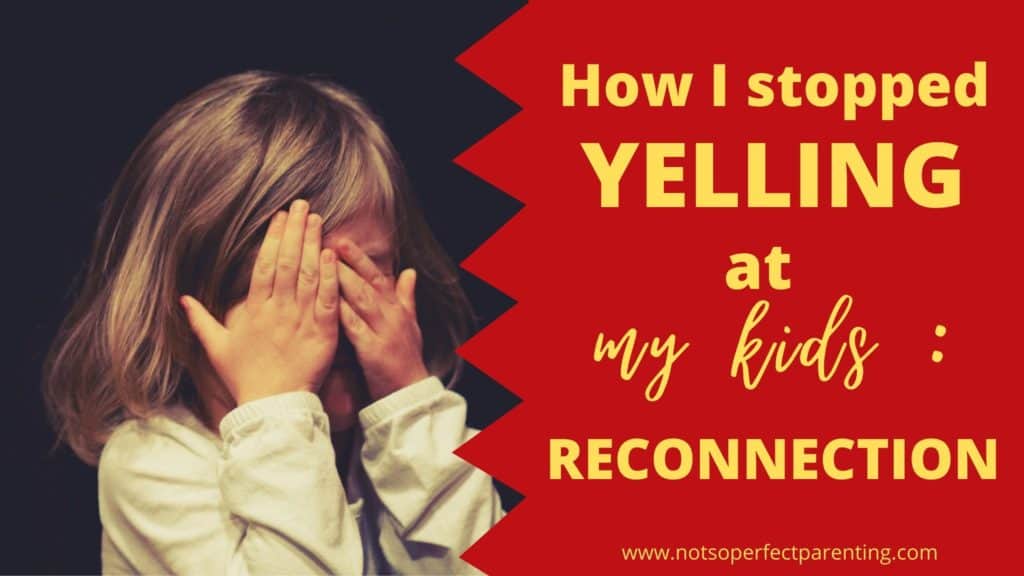

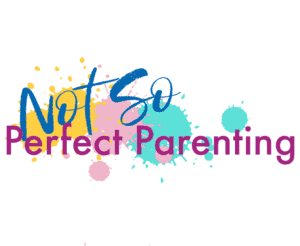
Pingback: 25 party ideas for 6 year olds - Design Collective
Pingback: 25 Best Games For 8-Year-Olds (Educational and Entertaining) - Teaching Expertise